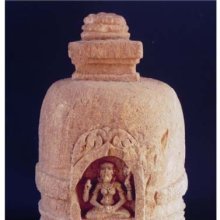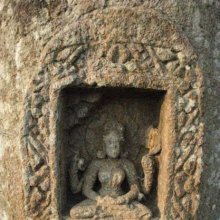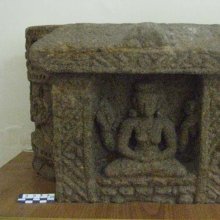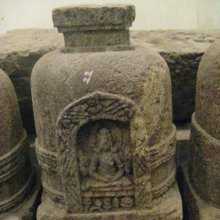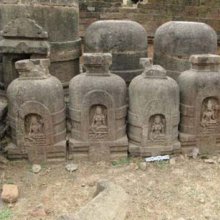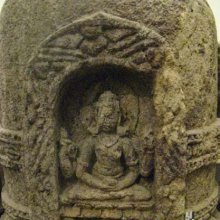Cunta, Cuṇṭā, Cuṇṭa: 9 definitions
Introduction:
Cunta means something in Hinduism, Sanskrit, biology, Tamil. If you want to know the exact meaning, history, etymology or English translation of this term then check out the descriptions on this page. Add your comment or reference to a book if you want to contribute to this summary article.
Alternative spellings of this word include Chunta.
Images (photo gallery)
(+4 more images available)
Biology (plants and animals)
Source: Google Books: CRC World Dictionary (Regional names)Cunta in India is the name of a plant defined with Solanum torvum in various botanical sources. This page contains potential references in Ayurveda, modern medicine, and other folk traditions or local practices It has the synonym Solanum indicum L. (among others).
Example references for further research on medicinal uses or toxicity (see latin names for full list):
· Revista Brasil. Genet. (1982)
· Misc. Austriac. (1781)
· Taxon (1982)
· Feddes Repertorium (1990)
· Feddes Repertorium (1988)
· Willdenowia (1991)
If you are looking for specific details regarding Cunta, for example pregnancy safety, health benefits, extract dosage, side effects, chemical composition, diet and recipes, have a look at these references.

This sections includes definitions from the five kingdoms of living things: Animals, Plants, Fungi, Protists and Monera. It will include both the official binomial nomenclature (scientific names usually in Latin) as well as regional spellings and variants.
Languages of India and abroad
Sanskrit dictionary
Source: DDSA: The practical Sanskrit-English dictionaryCuṇṭā (चुण्टा).—A small well or reservoir.
See also (synonyms): cuṇṭī, cuṇḍā.
Source: Cologne Digital Sanskrit Dictionaries: Shabda-Sagara Sanskrit-English DictionaryCuṇṭā (चुण्टा).—f.
(-ṇṭā) A small well or reservoir near a well. E. cuḍi to be low or shallow, affixes aṅ and ṭāp; also cuṇḍī, the fem. affix being ṅīṣ.
Source: Cologne Digital Sanskrit Dictionaries: Benfey Sanskrit-English DictionaryCuṇṭā (चुण्टा).— and ṭī, f. A well, [Suśruta] 1, 169, 12.
Source: Cologne Digital Sanskrit Dictionaries: Monier-Williams Sanskrit-English DictionaryCuṇṭā (चुण्टा):—[from cuṇṭ] f. a small well or reservoir near a well, [cf. Lexicographers, esp. such as amarasiṃha, halāyudha, hemacandra, etc.]
Source: Cologne Digital Sanskrit Dictionaries: Yates Sanskrit-English DictionaryCuṇṭā (चुण्टा):—(ṇṭā) 1. f. A small well.
[Sanskrit to German]
Sanskrit, also spelled संस्कृतम् (saṃskṛtam), is an ancient language of India commonly seen as the grandmother of the Indo-European language family (even English!). Closely allied with Prakrit and Pali, Sanskrit is more exhaustive in both grammar and terms and has the most extensive collection of literature in the world, greatly surpassing its sister-languages Greek and Latin.
Tamil dictionary
Source: DDSA: University of Madras: Tamil LexiconCuṇṭa (சுண்ட) adverb < சுண்டு²-. [sundu²-.] Completely, to the last drop; முற்றும். சுண்டக் கறந்ததினாற் கன்றுக்குப் பாலில்லை. [murrum. sundag karanthathinar kanrukkup palillai.] Local usage
Tamil is an ancient language of India from the Dravidian family spoken by roughly 250 million people mainly in southern India and Sri Lanka.
See also (Relevant definitions)
Starts with (+12): Cuntai, Cuntai varral, Cuntaikkayan, Cuntaikkirai, Cuntakan, Cuntakkattu, Cuntal, Cuntalam, Cuntali, Cuntam, Cuntan, Cuntankay, Cuntanki, Cuntankiyar, Cuntankolli, Cuntankoluttu, Cuntappana, Cuntappiti, Cuntara-murttinayanar, Cuntara-pantiyankol.
Ends with: Ceriyacunta, Cerucunta, Kantakariccunta, Kattucunta, Putricunta, Puttacunta, Puttaricunta.
Full-text (+21): Sunda, Upasunda, Nisunda, Chunda, Marica, Nikumbha, Cuntappiti, Dhundhu, Chunda kadalai, Kampilya, Cunda, N'sunda, Cunti, Cundhi, Sundasuravadhu, Sundopasunda, Devasunda, Cuntakkattu, Cudaka, Jhajha.
Relevant text
Search found 30 books and stories containing Cunta, Chunda, Cuṇṭā, Cuṇṭa, Sunda; (plurals include: Cuntas, Chundas, Cuṇṭās, Cuṇṭas, Sundas). You can also click to the full overview containing English textual excerpts. Below are direct links for the most relevant articles:
The Gospel of Buddha (by Paul Carus)
Stupas in Orissa (Study) (by Meenakshi Chauley)
Emanations of Vairocana < [Chapter 5]
Minor Structural Stupas at Udayagiri (Southern Zone) < [Chapter 4]
Drum slabs at at Ratnagiri < [Chapter 4]
Kathasaritsagara (the Ocean of Story) (by Somadeva)
Notes on the story of Sunda and Upasunda < [Notes]
Chapter XV < [Book III - Lāvānaka]
Chapter CXXI < [Book XVIII - Viṣamaśīla]
Mahabharata (English) (by Kisari Mohan Ganguli)
Section CCXI < [Rajya-labha Parva]
Section CCX < [Rajya-labha Parva]
Section CCXII < [Rajya-labha Parva]
Trishashti Shalaka Purusha Caritra (by Helen M. Johnson)
Part 1: Restoration of Pātālalaṅkā to Virādha < [Chapter VI - Bringing news of Sītā]
Part 3: Attempts to seduce Sītā < [Chapter VI - Bringing news of Sītā]
Part 9: Rāma’s grief < [Chapter X - Rāma’s mokṣa (emancipation)]
Ramayana of Valmiki (by Hari Prasad Shastri)
Chapter 25 - Vishvamitra seeks to convince Rama < [Book 1 - Bala-kanda]
Chapter 47 - Sita sees Rama and Lakshmana lying on the Battlefield < [Book 6 - Yuddha-kanda]
Chapter 20 - Dasaratha’s reluctance < [Book 1 - Bala-kanda]
Related products
